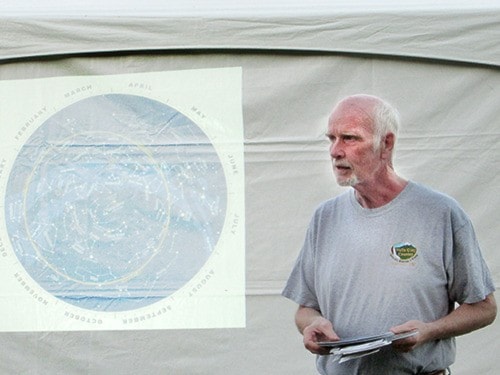The scene was set when we arrived at Trophy Mountain Buffalo Ranch for Clearwater’s seventh annual Star Gazing Festival on Aug. 8 as the sun descended below the horizon. Wells Gray Country services committee, which includes representatives of Upper Clearwater, Vavenby and Blackpool of TNRD Area A, hosted this event, with assistance from District of Clearwater and Tourism Wells Gray.
Rodeo Rednecks politely told us where to park; Raft River Rockhounds served at the concession; while youngsters participated happily doing star-related activities courtesy of Success by Six.
A view of the starry heavens was projected onto the wall of the marquee. Vancouver resident Bill Burnyeat, a representative of the Royal Astronomical Society of Canada, gave his presentation as the sky darkened.
“I go to many communities, usually setting up in parks, to share this with them,” he said, “and can be requested through this website: rasc-vancouver.com.”
On the field, three large telescopes were set up to view the night sky after the slide show.
The audience of perhaps 100, on comfy chairs or blankets, included every age group – a challenge for any speaker, but Burnyeat kept everyone enthralled. Mind you, he was almost upstaged as four sandhill cranes announced their presence with deep, rolling trumpeting calls, then circled the ranch – twice.
Burnyeat’s lecture, sprinkled with humour, was a combination of interesting facts and practical, easy-to-do-at-home astronomy.
“Ordinary binoculars work well in locating particular stars and for viewing constellations,” he noted.
He distributed planispheres, one per family, and explained their use in discovering which constellations are visible in the night sky at any given time of the year, and in tracking movement of planets. A later slide showed a homemade “sun dial” with which the North Star can easily be located.
“I took just one chop stick to make this,” he explained with a twinkle. “Since one just like it was left behind, no one will miss it!”
We learned about different colours of stars, that our Sun is a green star and, billions of years from now, our Sun will swell up. Stars that are cooler radiate most of their energy in the red and infrared region of the electromagnetic spectrum and thus appear red; hot stars emit mostly at blue and ultra-violet wavelengths, making them appear blue or white. The more red stars in a cluster, the older it is.
“You have to be 100 million years old to attend Kindergarten,” he quipped, giving us a sense of time in astronomy. “Light has been travelling since the Age of Dinosaurs for its appointment with us tonight,” he said of Andromeda Galaxy. By comparison, we see the moon’s reflected light 1.3 seconds after it is emitted.
The sky had darkened by the end of his presentation, but our evening was far from over. Looking up to catch sight of the first star to show up, by pure chance, the International Space Station whizzed by overhead “for your viewing pleasure!” A smaller light behind it may (or may not) have been a supply vessel.
It was now time to visit the three telescopes, the two extras being provided by Ron Vanderzwan of Clearwater and Bob Daoust of Birch Island.
“You might have a chance to see Saturn,” we’d be told. “There is nothing like it on Earth, for its rings are not attached.”
And there is was – low in the sky, so some did not see it through the telescopes as it soon dipped below the horizon. By then the sky was filled with stars, the Milky Way was visible, and other planets and constellations identifiable. It was a stellar performance.
